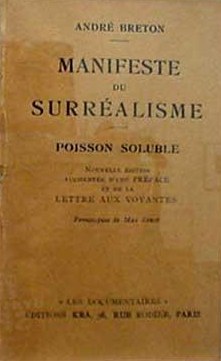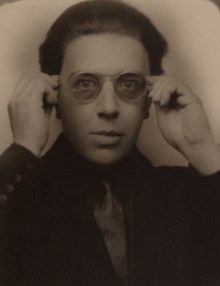





The Surrealism Website
Early History of Surrealism by Adam McLean
 The word surreal, coined by the French poet Guillaume Apollinaire in 1917, has so entered our language that we find it used by people in a general way to refer to
some strange or inexplicable situation. The prefix "sur" in the word gives it the meaning of above or beyond the real. Apollinaire's invented word would probably not have had any impact on the language if it had not been for André Breton adopting it as the name for the art movement he founded in 1924, when he issued his Surrealist Manifesto. This was born out of the avant-guard Dadaist movement which arose during the first world War and included Marcel Duchamp, Francis Picabia, Hans Arp and others.
The word surreal, coined by the French poet Guillaume Apollinaire in 1917, has so entered our language that we find it used by people in a general way to refer to
some strange or inexplicable situation. The prefix "sur" in the word gives it the meaning of above or beyond the real. Apollinaire's invented word would probably not have had any impact on the language if it had not been for André Breton adopting it as the name for the art movement he founded in 1924, when he issued his Surrealist Manifesto. This was born out of the avant-guard Dadaist movement which arose during the first world War and included Marcel Duchamp, Francis Picabia, Hans Arp and others.
The early decades of the 20th century saw the formation of various art movements (usually short lived), Fauvism, Orphism, Futurism, Vorticism, Cubism, Metaphysical art, the Suprematism of the Russian Malevich among others.
 André Breton, who had a background in Freudian psychotherapy and revolutionary politics, wanted to use Freudian dream analysis and an awareness of the unconscious as a method for freeing artistic imagination. His initial conception of Surrealism was as pure psychic automatism, the creation of works without any control exercised by reason, aesthetic or moral preoccupations. Centred in Paris, Breton gathered together under the surrealist banner, a group of artists including André Masson, Giorgio de Chirico, Max Ernst, Joan Miró, Francis Picabia, Yves Tanguy, and Salvador Dalí. Of course, Breton's Surrealism extended beyond the medium of painting to embrace literature, music, politics and even cinema. This website primarily deals with painting.
André Breton, who had a background in Freudian psychotherapy and revolutionary politics, wanted to use Freudian dream analysis and an awareness of the unconscious as a method for freeing artistic imagination. His initial conception of Surrealism was as pure psychic automatism, the creation of works without any control exercised by reason, aesthetic or moral preoccupations. Centred in Paris, Breton gathered together under the surrealist banner, a group of artists including André Masson, Giorgio de Chirico, Max Ernst, Joan Miró, Francis Picabia, Yves Tanguy, and Salvador Dalí. Of course, Breton's Surrealism extended beyond the medium of painting to embrace literature, music, politics and even cinema. This website primarily deals with painting.
 The pure surrealism of Breton's manifesto did not survive long, indeed Breton's own adopted patron, Sigmund Freud, came to realise that rather than being experiments in psychic automatism they were instead products of the conscious, not the unconscious mind. It is reported that he said to Salvador Dalí when they met in London in 1938 that "It is not the unconscious I seek in your pictures, but the conscious..." Dalí had taken his recently finished Metamorphosis of Nascissus painting to show to Freud, but the father of psychoanalysis could not see Dalí's art as direct manifestations of the unconscious, but as being greatly shaped and processed by the ego.
The pure surrealism of Breton's manifesto did not survive long, indeed Breton's own adopted patron, Sigmund Freud, came to realise that rather than being experiments in psychic automatism they were instead products of the conscious, not the unconscious mind. It is reported that he said to Salvador Dalí when they met in London in 1938 that "It is not the unconscious I seek in your pictures, but the conscious..." Dalí had taken his recently finished Metamorphosis of Nascissus painting to show to Freud, but the father of psychoanalysis could not see Dalí's art as direct manifestations of the unconscious, but as being greatly shaped and processed by the ego.
Though from Breton's perspective the surrealist movement began positively with a number of artists joining its ranks, with even a group being formed in Belgium, but he found it difficult to hold all of them to his conception of what surrealism should be. In 1929 he had to issue a Second Manifesto of Surrealism, which appears more as a cry of despair.
"We combat, in whatever form they may appear, poetic indifference, the distraction of art, scholarly research, pure speculation; we want nothing whatever to do with those, either large or small, who use their minds as they would a savings bank."
Not all artists wished to be such hard line automatists, they wanted to use their conscious minds to create their artworks, but this to Breton was a terrible error.
He tried tried to encourage people to write 'automatically' to be free of the constraints of tradition in art and he had some of the artists in the group draw exquisite corpses. These were collaborative works usually drawn on a piece of paper folded into three or four sections. One artist would create a drawing in the bottom section then fold the paper only leaving a small section showing, which then another artist would complete without seeing the first image.
By the early 1930s the pure surrealism envisaged by Breton had all but disappeared with Dalí, Magritte, Delvaux, Tanguy and others painting in their own individual styles. Though still adhering to the surrealist group, each of these artists was pursuing their own agenda and developing their own pictorial language. By the end of the 1930s surrealism had clearly evolved away from Breton's control but became the general title for a style of imaginative figurative works.






 The word surreal, coined by the French poet Guillaume Apollinaire in 1917, has so entered our language that we find it used by people in a general way to refer to
some strange or inexplicable situation. The prefix "sur" in the word gives it the meaning of above or beyond the real. Apollinaire's invented word would probably not have had any impact on the language if it had not been for André Breton adopting it as the name for the art movement he founded in 1924, when he issued his Surrealist Manifesto. This was born out of the avant-guard Dadaist movement which arose during the first world War and included Marcel Duchamp, Francis Picabia, Hans Arp and others.
The word surreal, coined by the French poet Guillaume Apollinaire in 1917, has so entered our language that we find it used by people in a general way to refer to
some strange or inexplicable situation. The prefix "sur" in the word gives it the meaning of above or beyond the real. Apollinaire's invented word would probably not have had any impact on the language if it had not been for André Breton adopting it as the name for the art movement he founded in 1924, when he issued his Surrealist Manifesto. This was born out of the avant-guard Dadaist movement which arose during the first world War and included Marcel Duchamp, Francis Picabia, Hans Arp and others.  The pure surrealism of Breton's manifesto did not survive long, indeed Breton's own adopted patron, Sigmund Freud, came to realise that rather than being experiments in psychic automatism they were instead products of the conscious, not the unconscious mind. It is reported that he said to Salvador Dalí when they met in London in 1938 that "It is not the unconscious I seek in your pictures, but the conscious..." Dalí had taken his recently finished Metamorphosis of Nascissus painting to show to Freud, but the father of psychoanalysis could not see Dalí's art as direct manifestations of the unconscious, but as being greatly shaped and processed by the ego.
The pure surrealism of Breton's manifesto did not survive long, indeed Breton's own adopted patron, Sigmund Freud, came to realise that rather than being experiments in psychic automatism they were instead products of the conscious, not the unconscious mind. It is reported that he said to Salvador Dalí when they met in London in 1938 that "It is not the unconscious I seek in your pictures, but the conscious..." Dalí had taken his recently finished Metamorphosis of Nascissus painting to show to Freud, but the father of psychoanalysis could not see Dalí's art as direct manifestations of the unconscious, but as being greatly shaped and processed by the ego.